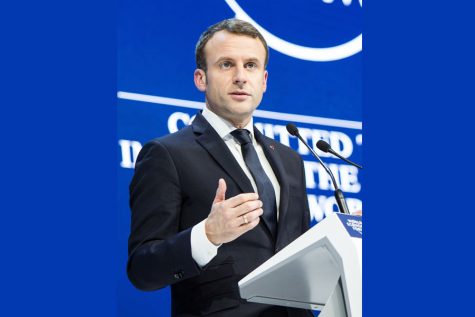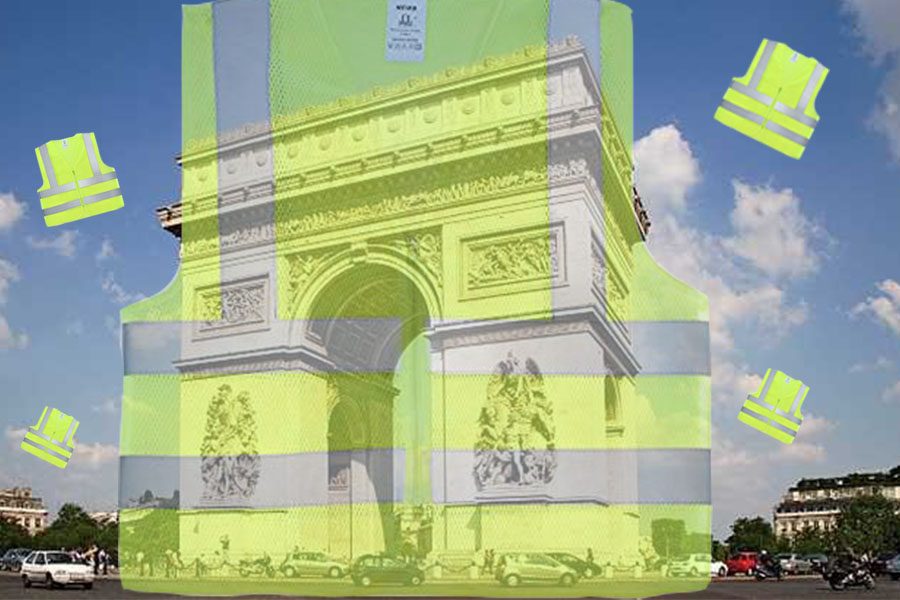Furor in France
Protests have broken out all across France over the rising fuel costs.
Massive protests have erupted all across France in the last two months.
Al Jazeera, a media company based in Qatar, traced the mayhem back to October 18th, 2018 when Jacline Mouraud posted a video addressing French President Emmanuel Macron. In the video, she talks about the unfair fuel price increases and how it is affecting drivers.
A petition was then made online to bring down the price of fuel.
According to BBC News, Saturday, November 17th, 2018 was the first day of nationwide protests against the rising fuel prices. Over 280,000 people wore bright yellow vests, which are required by law to be kept in cars, as a protest. More than 600 people were injured and two people were killed.
The very next day, November 18th, the French government released a statement saying that the government will not back down. The following Saturday, November 24th, is when the next wave of protests took place. BBC News reported that more than 5,000 demonstrators were met with 5,000 law enforcement officers on Champs-Elysees in Paris.
Police barriers were set up all around the Champs Elysees to try and restrict access to crucial buildings including the National Assembly and the President’s Office.

Tearing down street signs, lighting fires, pulling up paving stones and throwing them at police, all while shouting indignant phrases about President Macron occurred throughout the afternoon even though the majority of protesters were peaceful.
Officials reported that 19 people were injured and that included four police officers. 130 arrests were made overall. There were over 160,000 protestors across France that day; all were peaceful except the riots in Paris.
A video of the protests in Paris can be watched here
Al Jazeera stated that November 27th was when people first saw President Macron speak out about the protests. He offered to adjust tax increases and called for a three-month national consultation. This, however, did not impress protesters. The “yellow vests” called for another protest on December 1st, 2018 again along the Champs-Elysees.
According to The New York Times, violence erupted again. Protestors burned cars, confronted police officers, and smashed windows. Eventually, tear gas was brought out causing protesters and vandals to scatter. One of Paris’s famous landmarks, The Arc de Triomphe, was severely defaced during the protests. “Emmanuel demission” (Emmanuel resignation) and “Les gilets Jaunes” (yellow vest movement) were both spray-painted on the outside of the monument among many other phrases.
A video of the December 1st riots can be found here
Benjamin Griveaux, a government spokesperson, announced that France would consider declaring a state of emergency to prevent a reoccurrence. President Macron Emmanuel also condemned the actions that took place on December 1st, saying, “What happened today in Paris has nothing to do with the peaceful expression of legitimate anger, nothing justifies attacking the security forces, vandalizing businesses, either private or public ones, or that passers-by or journalists are threatened, or the Arc de Triomphe defaced.”
BBC News reported that there were 263 people wounded and that over 630 people were being held in custody. More than 136,000 people took place in the protest around the country, according to the French government. To add even more fuel to the fire (literally) President Macron was 7,000 miles away in Buenos Aires at the time attending the G20 economic summit meeting. The actions on and leading up to December 1st showed that the French government could not ignore these protests or sweep them under the rug any longer.
What happened today in Paris has nothing to do with the peaceful expression of legitimate anger, nothing justifies attacking the security forces, vandalizing businesses, either private or public ones, or that passers-by or journalists are threatened, or the Arc de Triomphe defaced.
— President Emmanuel Macron
Prime Minister, Edouard Philippe, announced on December 4th, 2018, that tax increases on diesel would be suspended for six months. Spikes in electricity and gas prices will also be frozen during the wintertime. The very next day, President Macron said that all of the currently planned fuel tax hikes would be dismissed in 2019.
These announcements, however, did not appease the yellow vests who then decided to protest again on December 8th, 2018. BBC reported that 125,000 protestors were on the streets in Paris and over 1,200 of them were taken into custody by law enforcement. Windows were smashed. Cars set on fire. Shops looted. There were fewer injuries, but there was much more damage brought upon the city than in any past protest.
According to The New York Times, at least 50 members of parliament have been threatened and had their offices and homes vandalized by the yellow vests, most were President Macron’s deputies. Journalists are also becoming targets – threatened, beat, punched to prevent them from doing their work.
So why exactly is France participating in, as The New York Times describes, the worst civil unrest in more than a decade?
Is it really only about increasing fuel prices? Have these protests unlocked what years of angry citizens have held towards the government and their policies? Or maybe towards President Macron or as some have dubbed him “President of the Rich”?
BBC News reported that the price of oil has risen up to 20% since the start of 2018. This increase is mostly due to France’s new series of “green taxes” in hopes that it will lower air pollution and protect the environment. Many protesters believe that it punishes the people who need cars and that taxes should instead be put on industries causing pollution. President Macron insists that three-quarters of the world oil prices are to blame for the price rise, and only a small fraction is to sponsor renewable energy projects.
Even though these protests did start out over the “ridiculous” price of fuel, other issues have since bubbled up, including a call for lower taxes, higher wages, and better pensions.
Taxes between the United States and France are compared in the infogram below:
All of these issues highlight the frustration, especially economically that working families are feeling. Political distrust is also rampant among poorer families.
In the infogram below the cost of living in France is compared with the cost of living in the United States:
General anger and dissatisfaction about President Emmanuel Macron leadership has been a continual occurrence during the protests and many protesters have criticized him as favoring the wealthy and elite.
BBC News also pointed out that protests are not uncommon in France, but they usually have some sort of political/union leader, either a person or organization. The yellow vest movement has no prominent leader, no structure, or political group. People of all ages and various political parties, some that even once supported Macron are united together for this movement.
These protests are ongoing, and this is the 10th week of protests after a slight dip during the holiday season. President Macron has rarely been out in public due to the high risk these protests bring and his approval rating, according to The New York Times, is at a dismal 30% which is actually a slight rise from the previous weeks.
Laurel is a senior at Sartell High School. She enjoys spending time with her friends and family and also watching Netflix in her free time. Her favorite...













